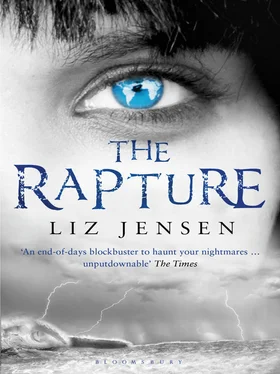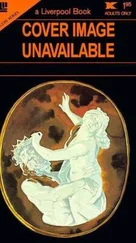‘Right,’ I say, my eyes now accustomed to the sprawl Frazer Melville works in. ‘You’ve got me here. So now explain.’
He points at the wall next to the van Goghs, where there is a large graph dotted with tiny arrows. ‘It’s called the Kolmogorov Scaling Pattern. It’s a formula used by physicists to predict the speed and direction of particles in relation to other particles in a fluid. The kind of swirl you get when cream meets coffee, or smoke comes out of a chimney. There are even some economists who claim to see its patterns in the fluctuations on the foreign exchange markets. Now do you see the comparison between the Kolmogorov Scaling Pattern and the van Gogh skies? And between van Gogh’s skies and Bethany’s?’
‘Up to a point. But a swirl’s a swirl. Right?’
Apparently not. They have a structure, he tells me, a narrative: they map a complex dance of currents and counter-currents. And van Gogh had epilepsy.
‘How’s that a factor?’
‘Some years ago a Mexican physicist, Josi. Luis Aragbn, became interested in van Gogh’s skies. He analysed them mathematically.’ Frazer Melville is shoving a scientific paper at me. I read through the abstract, by Aragon et al.
We show that some impassioned van Gogh paintings display scaling properties similar to those observed in fluids, suggesting that these paintings reflect the fingerprint of turbulence with a realism consistent with the way that a mathematical model characterises this phenomenon. Specifically, we show that the probability distribution function (PDF) of luminance fluctuations of points (pixels) separated by a distance R is consistent with the Kolmogorov scaling theory in turbulent fluids. We also show that the most turbulent paintings of van Gogh coincide with periods of prolonged psychotic agitation of this artist.
‘These three were painted when he was suffering from frequent bouts of epilepsy,’ says Frazer Melville. ‘In this paper, Aragon shows how they actually map turbulence — invisible turbulence — with extreme accuracy. And he goes on to speculate that the delusions accompanying van Gogh’s epileptic fits might have given him a unique understanding of the physics of flow.’
‘And Bethany’s ECT—’
‘Those currents are giving her a grand-mal seizure. A similar experience to an epileptic fit. But it’s induced artificially and controlled, rather than arriving spontaneously through a brain malfunction.’
‘You mean there might be some kind of science to explain what she’s predicting?’
‘There has to be. At least, for what she’s claiming to feel. But as for how she can pinpoint the location and the date — I have no idea. I’m hoping there’s a clue in the notebooks.’
I fish them out of the bag and lay them on the desk. Taking the top one, he flips through the pages eagerly, but soon his expression shifts from interest to dismay. ‘Christ. It’s total chaos.’
‘What were you expecting — rational method? But there’s probably a pattern in there somewhere. If we can find it.’
‘How?’ he says, surveying a scrawled-over page despairingly.
‘If she writes on consecutive pages, there’d be a chronology to them.’
He continues to flick through. Some pages are chock-a-block with tiny, cramped notes, interrupted by sketches peppered with arrows. Others are devoted to freehand drawings, some of ordinary-looking clouds, others similar to the storm images Bethany made in the studio when she drew the Rio Christ. Ten or twelve pages of the most recent notebook — only a third full — are devoted to a series of what I think of as her ‘machinery-in-moonscape’ drawings. The style of these is more diagrammatic and observational, less emotionally charged than the others. There is a structure to them, an almost architectural formality that gives the impression of something that has been copied to scale, something that actually exists beyond Bethany’s imagination, and has its roots in reality. They make no sense to me but Frazer Melville seems struck by them. ‘Interesting,’ he murmurs, stroking a page as though it might contain hidden Braille. ‘No turbulence. Nothing at all, in terms of air-flow. I wonder what she’d do if I asked her to imagine it. What it would look like.’ The scenario is the same in all of them: a rubble-strewn stretch of land and a vertical line — sometimes thin, sometimes thick — descending from the sky to hit a flower-shaped cup or funnel at ground level, which continues underground and then curves, travelling horizontally and ending either in vagueness, or in a wedge shape, or in what appears to be an explosion. On the earth, around the funnel, Bethany has drawn broken rocks, or scree.
‘What does this represent?’ I asked her once.
‘I don’t know,’ she said. Edgily, as though I’d cornered her doing something shameful. ‘But I keep doing it.’
‘I’ll give you my psychologist’s take on these,’ I tell Frazer. ‘There’s no evidence I know of that she’s been sexually abused, and she hasn’t told me it happened. But I think it did. Or something like it. A violent invasion. Now you tell me your guess.’
‘I can’t. But I think they’re too technical to be symbolic. To me they look like some kind of mining operation.’
‘And what about these ones?’ I ask, leafing through to show him another Bethany motif: a collection of geometric-looking, five-sided forms packed together in a block. ‘A honeycomb? A multistorey car park? Stylised coffins?’
‘I’m going to run all this by my ex,’ says Frazer, sighing. ‘But she’ll probably say it’s hyessou.’
‘What’s hyessou?’
‘It’s Greek for a load of bollocks,’ he says miserably. ‘Knowing Melina, she’ll assume that my mother’s death has unhinged me.’
The routine we now embark on is meticulous. Methodically, for the next two hours, with little talking, we go through the notebooks page by eccentric page, numbering them as we go along, with Frazer Melville making photocopies and taking digital photographs which he transfers to his computer.
‘All done,’ he says finally, setting the last, incomplete book down on the desk. I pick it up and riffle through the pages. She has used different coloured pens for her drawings, but all the text is in scrawled black. Then I stop. The very last page is covered in handwriting.
‘Did you copy this?’ I ask Frazer Melville. He looks across, exhausted and puzzled. ‘It looks like a list.’
‘Let’s have a look,’ he says, pulling his chair up next to mine. It’s a set of dates, places and events. Some are written in black, and others in green, red or blue, as though there’s a kind of code to it. The first reads, February 11th. Volcanic disturbances, Mount Etna, Italy.
‘There was some activity back then,’ says Frazer Melville. ‘Before the big eruption in May. Though I’m not sure of the exact date. I could check it.’
‘She could have written it down afterwards,’ I say. ‘Look at the way she’s used different colours. This certainly wasn’t all written in one go. What’s next?’
‘February 4th cylone, Osaka, Japan,’ I read. The list goes on, through March and April: a tornado in southern Spain and new geyser in Iceland, a black cloud formation in Russia, a deadly methane belch from a lake in the Congo. One by one, as I read them out, Frazer Melville looks up the events on the net. In each case, they not only happened, but happened on the dates Bethany has noted in her red and black book. The eruption of Mount Etna on March 18th. An earthquake in Nepal and a typhoon in Taiwan on April 20th and 29th respectively. They too are there. May 21st. Rock falls in the Alps : we both remember that story in the news. A Swiss village was destroyed, because of permafrost thawing below the mountain slope, and unleashing its grip on the granite. Something churns inside me uneasily as I recall the footage.
Читать дальше












